Also, you may explore the website for the American Academy of Cosmetic Dentistry: aacd.com to find more about cosmetic dentistry problems. Since Cosmetic Dentistry is not a recognized specialty, this organization provides accreditation for those dentists that seek to build their expertise in this area in a responsible way.
Organization of this Chapter
You May Skip to Whatever Subject Interests You Now
Basic Concepts
Deviations and Abnormalities – 12 Types
Variations in Natural Esthetics – Genetics
Deviations in Appearance and Esthetics due to Past History
Bottom Line for Esthetic Deviations
………………………………………………………………………………………………………………………..
Cosmetic Dentistry Problems: Basic Concepts
Having considered all of the aspects of what makes a person appear “normal”, as determined by oral conditions, in Chapter II.6 – we now proceed to look at how people typically deviate from this normalcy (normality?).
As stated before, cultural bias has a huge part in determining, not how a person appears, but how they appear to others!
If a person talks to you and gets the idea that something is wrong with you because of your teeth or cheeks or lips or the way you pronounce words, that is not good. There probably is nothing wrong with you, so giving the impression that there IS is a bad thing.
I am reminded of an artist I met some years ago in an art gallery. He was a sculptor with some work in the gallery, and about 78 years old, as far as I can make out. I had a short conversation with him – covering no more than one minute – but drew strong conclusions about his dental history. A person talking with him that is not trained in dentistry probably would not have noticed just what I did, certainly not in any detail, but more likely would have come away with the feeling that there was something “off” about him, and move away. The problem is that he had had cosmetic dentistry done on the upper anterior teeth, and the abrasive porcelain had ground the lower teeth down so much as to show the deep insides of these teeth. The lower teeth had been ground off beyond the original pulp chamber, slowly enough for it to have been filled in with dentin, but this new dentin is readily stained and showed up as red dots in the center of teach of the ground off edges. With a low smile line, these dots were readily observable conversationally, and quite unsightly!
The point of the last story was that unconscious impressions are often made by the appearance of the teeth and surrounding structures, and these can affect not just a person’s appeal, but also on their business success.
In this section we will catalog specific areas of deviation from idea. In Chapter V.18, we will discuss how to remedy esthetic concerns.
Cosmetic Dentistry Deviations and Abnormalities – 12 Types:
- Smile Location. Your teeth and your lips may not match! If your lips generate an opening that is shifted upward compared to your teeth, the upper gingiva are more readily seen than typical, and you have what is called a “gummy smile”. On the other hand, if the opening is shifted downward, the lower teeth are seen more than usual. Since these lower incisors are often crowded, this is not typically attractive. Also, with a lower smile line, the maxillary teeth, which are so important to appearance, may be rarely seen. Ideally, when you smile the upper lip exposes the incisal edges of the upper teeth uniformly, the wider smile the more exposure, but not so far as to see much of the gingiva. IF your smile line is not normal, there is little that can be done about it without major surgery, but we can make sure that whatever IS seen looks as normal as possible.
- Lip support. For the upper lip, particularly, to be recessed or protruded, because the teeth don’t support it beyond the lower lip to achieve a “normal” profile, we will have an esthetic effect. This deviation may be due to tooth position, or boney ridge position or both. Of course the teeth tend to be positioned relative to the ridge, but not necessarily ideally. And, as time progresses, some patients have upper teeth that flare outward, either through tongue thrusting, or a combination of tongue thrusting and loss of bone support due to periodontal disease. Corrective measures can be taken to an extent, to be discussed later. But, realize, that the dentist may be responsible for the lip support, and hence profile, as they restore anterior teeth. If they make a poor decision, your appearance from the side may be impacted adversely. You won’t be aware of it as you look in the mirror, but your friends will notice. Good friends will say something, and you can pursue corrective measures. This discussion does NOT just apply to people with teeth – but for people with full dentures especially! With dentures the position of the upper lip is critical, and very much adjustable by the person designing the denture.
- Bulgy cheeks. While the dentition, and particularly the occlusion, may be involved in the stimulation of clenching and the enlargement of the biting muscles, it is more likely that this is a stress response to something other than the bite. Can the tendency to clench the jaws with emotional stress be altered by correcting the bite? Maybe. This is an individual consideration and depends on the insights of the dentist. Any dentist that says he can do this, if he doesn’t make his practice all about occlusion, and have decades of experience, is stretching the truth! If you find bulgy cheeks unappealing, or if you are breaking teeth at a rapid pace with this stress, I would recommend starting stress-reduction therapy, followed by modification of the bite to make sure there are not interferences that are annoying at some level, and that weak areas are restored to protect them.
- Speech. If you are having trouble with pronunciation of certain sounds, particularly “s”s, and your speech pathologist thinks that the position of your maxillary anterior teeth may be affecting the therapeutic outcome, you might want to discuss this with your dentist. Let me rephrase that: you might want to discuss this with a carefully selected dentist. Altering the natural tooth position to improve speech is a very unusual procedure in the dental community. Yes – we adjust dentures to get the best ability to pronounce certain sounds, but this is different from adjusting natural tooth positions. Let’s say that your upper incisors are protruded far beyond normal, making an anterior open bite. Maybe your lower lip won’t touch the upper incisal edges normally when trying to make the “f” sound. Then, moving or crowning (or both) these anterior teeth may make a big difference. More on this later – but I am here just illustrating the nature of the problem.
- Tooth alignment. Of course, there may be problems in anterior alignment and in posterior alignment. Would all malalignment problems lead to an esthetic problem? I always think of Keira Knightly in this regard. She has what is called Class II Division II occlusion, in orthodontic circles. Her maxillary incisors are protruded outward because they were blocked out during eruption (there was insufficient room). Now, would she be as gorgeous with her teeth aligned? I think not … for certain people, depending on the rest of their face, and even on their PERSONALITY, alignment deviations seem to fit. But, most of us are not inherently gorgeous, and alignment problems detract from our appearance significantly. This also depends on the visibility of the malaligned teeth, which has to do with the mobility and position of the lips.
- Spaces or diastema. Spaces between the anterior teeth for kids is perfectly normal, and desired so that they guide the permanent teeth into the correct locations, with enough room. But, for adults, the appearance of anterior spaces is not appealing generally. On the other hand, David Letterman, the famous late-night talk show host, had a particularly noticeable diastema between his two central incisors. Certainly he could have had this closed by constructing crowns or adding plastic to the teeth, but maybe the centrals would then look too wide! I would guess that a dentist would have done a study for him with models of his teeth that were built upon with white wax to simulate prospective treatments, and that observation of the results suggested leaving well enough alone. On the other hand, the diastema does shift personality, or perceived personality, to some extent. Maybe he was a better interviewer because his visitors perceived that he was less threatening because he was not perfect? This question is just to give you reason to think that deviation from ideal is not always a bad thing, and does not have to be corrected, even if recommended by a “professional”. Few professionals have awareness of all of the connected issues. You might spend some time thinking along these lines about Barbra Streisand’s nose ….
- Gingival Appearance. We’ve talked about the lip positions, as to some extent determined by tooth locations, and how this might affect visibility of the gums. But, how do the gums look? Perhaps you are suffering from a bad case of gingivitis. The inflammatory response to infection in the gums that has not produced attachment loss (visit Chapter III.2), is gingivitis. The hallmarks of inflammation are red color, puffy, swollen shape, bleeding readily and tenderness. Picture a splinter that has sat in your finger for a couple of days. When you have red, swollen gingival margins around your teeth, if these can be seen, they are definitely unsightly!
- Gingival Level. Also, if your gingiva around the teeth can be observed conversationally or when you smile or laugh, if the gingival margin has receded down the surface of the tooth, it produces an unappealing look. Whether the gingival margin is swollen and red or not, with enough RECESSION, the CEJ (the start of the root) can be seen, and the space between each tooth UNDER the adjacent contact can be seen, as a dark triangle. Dentists refer to this as “triangle disease”. The gingival papillae, those pointy parts of the gum, are supposed to fill this area – but if there is enough shrinkage of the gum tissue down the tooth, then the black space is visible. If there is a gummy smile in this area, it can be unsightly, indeed. Some people have even gone so far as to have pink plastic appliances made which snap over the anterior teeth to make it look like the gingiva is higher and covers the black spaces. These appliances are not permanent or worn often, so are generally referred to as “party gums”!
- Variations in tooth shape. Other than cultural or regional variations, which are minimal and not especially socially impactful, there are times when developmental issues lead to poor formation of the enamel over the tooth, and irregular shapes. This is usually not due to some disease state or pathology, but can be caused by experiencing a high fever at an early age, before one year old. I have seen this many times when my Chinese students bring in their friends as possible board patients, and their friends show this enamel hypoplasia (under development). They always reported that they had a high fever at an early age, which would interrupt the enamel formation in the early tooth before eruption. It turns out this has been quite common in China, perhaps due to limitations in drugs in certain areas. The teeth most affected are maxillary incisors and first molars, all of which are in a critical time of development at this age.
- Variations of shade and transparency. As we’ve discussed, the most common variations in these are due to age – the enamel becomes more transparent with age, and it allows the observation of the color of the dentin below (visit Chapter II.6). One can be sensitive to this of not. Perhaps it depends on who you hang out with, or who you want to partner with. In wealthy communities many of the older people have veneers and crowns done do eliminate these variations. The nature of these restorations will be discussed later in detail (visit Chapter V.18). I, personally, have my own teeth in front, and they look my age – but this is common with people around me that I admire. If there were any interest in attracting a much younger woman, for example, I might have some work done. But, as we’ll see later, and have mentioned above, if the gums are receded, placing crowns or veneers on the upper front teeth may still leave an unnatural appearance. Nonetheless, these variations and deviations that come with age can be corrected to some extent, but it is each person’s choice whether to do so. On the other hand, there are staining situations that are more likely to be offensive in comparison to others, and restored. Two situations that lead to dramatic intrinsic staining (within the tooth surface) are due to systemic issues. One is relatively unusual these days, staining of the teeth bluish-gray due to use of tetracycline at a young age (first couple of years, when teeth are developing in the bone). The second is when someone lives in a community where the level of fluoride in well water is very high. This gives a mottled appearance to the teeth, but it only occurs at extremely high concentrations, far above what is used in community water fluoridation. Two things to keep in mind: when you are raising a small child, you might calculate the total fluoride they receive, adding together that from the water supply, plus an even higher concentration from fluoride toothpaste IF they swallow the toothpaste, AND the possibility that the dentist will prescribe fluoride tablets. All together, it could potentially cause staining. Your dentist will be able to help you with this. Also, note that these staining situations are INTERNAL – not external, such as might be removed by simply cleaning the teeth well.
- Variations in Form with Age. These deviations from ideal correlate with age only because problems of wear and breakage tend to happen over time. We’ve discussed grinding the teeth and the wear it creates – and especially when it happens on the upper anterior teeth it is noticeable and bothersome. For example, someone may grind the edges so that the teeth are shorter than they were originally. When the shortening is enough, the incisal edges of the upper central incisors and the lateral incisors are at the same level – and are flat across the four. Even the canines can be involved, wherein their sharp cusps are flattened and these flat edges align with the incisors, creating a flat surface including six teeth. This is what I call the “Board Room Smile”, commonly observed in high powered executives with lots of stress in their lives. Otherwise, the incisal edges can be ground more on the inside surface, creating a sharp ridge of weakened enamel on the outside, facial and visible area. This thin edge of enamel will tend to chip away in pieces, leaving you with a “saw tooth” edge, which is unappealing. Also, we often see fracture of teeth in the anterior – in fact I have a fractured corner of a central incisor due to running headlong into a closed sliding glass door to a patio during a move 10 years ago. Friends in the dental community have offered to repair it, but I have elected not to.
- Missing teeth. Most people will take care of missing anterior teeth, especially on the upper arch, if the empty space is readily visible. Just last week I was watching a competition talent show on TV and there was a contestant with a missing maxillary incisor. His lip line was rather low, so it was not very visible, but one has to wonder if he is altering his facial muscles to FORCE his lip down to cover missing tooth areas because he is internally sensitive about it. It certainly suggests diminished financial resources – but even more than that, it may affect his appearance due to compensating movements of his entire face! Upper anterior teeth are often missing in young men in Canada – curious why? Ice hockey! Playing on frozen lakes without the helmets required by organized sports often leads to loss of teeth. I am lucky that in my hockey days I never got on the receiving end of a puck. Otherwise, the most common causes nationwide are likely to be car accidents or bar fights. Missing anterior teeth are expensive to replace! We’ll address possibilities in restoration later (visit Chapters V.7 and V.18). Posterior teeth are less likely to be an esthetic issue, but I once had a patient come to my practice with two premolars on the upper left missing – at least to the gum level. The two roots were still there, but polished flat to the gum level, not seen at all conversationally. She announced she’d been saving her money and finally had $500 to replace the teeth. I often give this challenge to my students and ask what they would do for that price, when a root canal costs almost that much and crowns more than $500 at that time. Restorative options will be discussed at length later, but this was a very interesting case – illustrating that no matter how much a dentist wants to help a patient with an esthetic concern, without destroying their financial future, it may not be possible. In this case I found a solution that the patient was happy with, for the money she had.
Variations in Natural Esthetics – Genetic
Our genetics determines how our appearance will be naturally – and it may deviate from what is accepted as the “social norm”.
There are just a few examples of this in the pictures below.
None of these variations in appearance have anything to do with what the patient DID, or habits they have. It is just how things developed naturally.
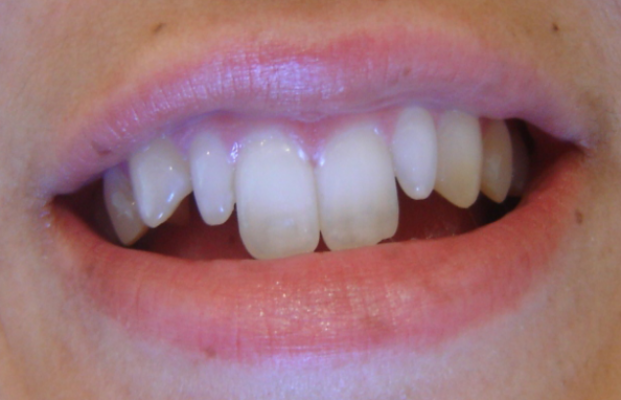
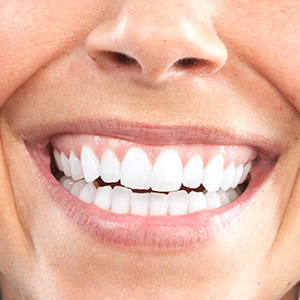
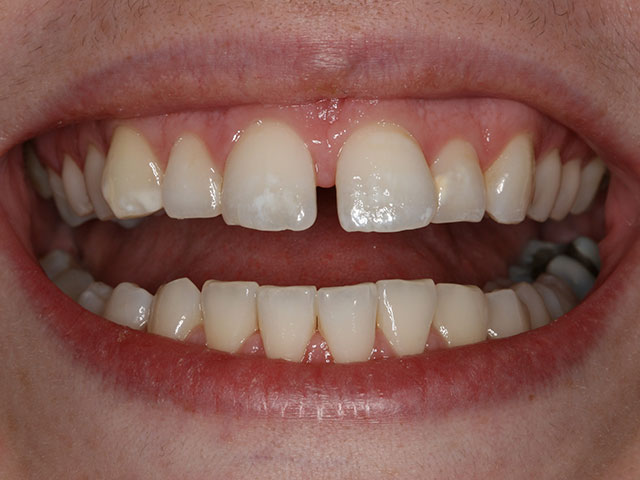
Deviations from Normal Dentition and Appearance due to Past History
In each of the situations depicted by photographs below, the esthetic concern is a direct result of something the patient DID, or what was DONE TO THEM. These things tend to accumulate over time as the patient ages.
Wear to the teeth – either due to the natural teeth grinding on each other because of functional habits on the part of the person, or a more aggressive wear caused by ceramic restorations of some teeth that grind away opposing natural teeth.
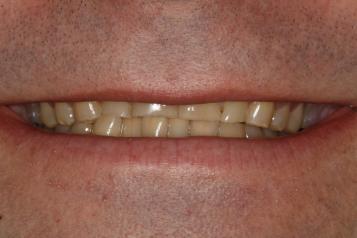
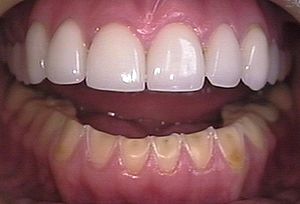
Erosion of the teeth – on the inside of the mouth potentially due to Bulemia, where the stomach acid dissolves away the enamel – or on the outside of the teeth often from eating lots and lots of lemons. I’ve had patients that loved to eat lemons. When observing their eroded teeth I would typically just ask from the start how many lemons per day they ate, and the answer was usually 5 of 6 – entire lemons. My theory, by the way, is that these people have some kind of malfunction of their SOUR taste buds, so that lemons TASTE sweet.
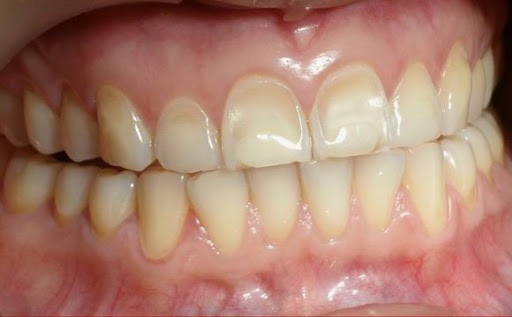
Fracture of the teeth – commonly the top front teeth, where they are hit my something preferentially, as they are more protruded. I have a fractured corner of a central incisor, due to running into a sliding glass door as I was moving into a new house! If they had only NOT cleaned the glass so well ….
Old crowns and restorations – when the dentist installs crowns into a patient’s mouth, if the opacity, or shape or position of the crowns is poorly chosen, it will have an esthetic impact. On the other hand, they may be nicely done, but over time the gumline recedes and shows a discoloration at the edge of the crowns either due to some metal showing, or because some of the root is showing. In either instance, this is not esthetically pleasing.
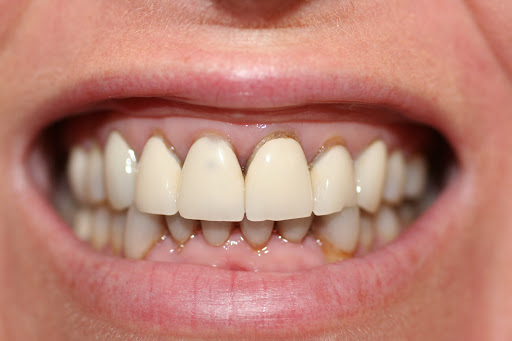
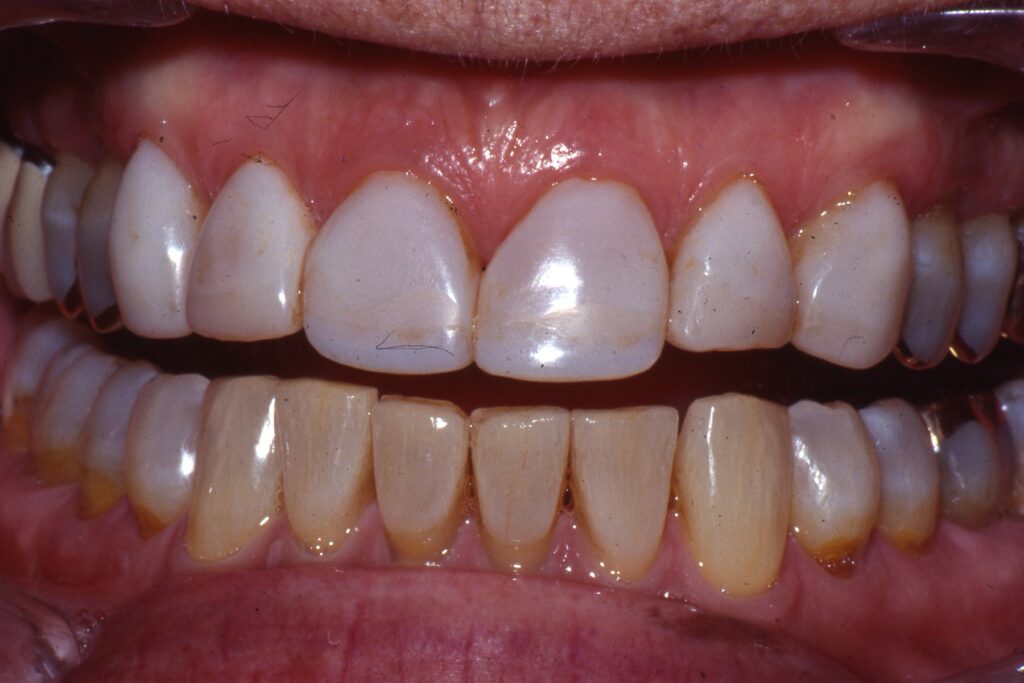
This patient had composite resin veneering done on the canines and incisors. They have a pasty look and the central incisors are bulgy looking compared to how they should look. It is possible that the dentist filled in a space (diastema) between the centrals and made them unnaturally wide as a consequence. The replacement of these with porcelain veneers will be shown in Chapter V.18.
Bottom Line for Esthetic Deviations
The bottom line in this section is that there are variations in the structures in and around the mouth that have impact on our appearance, but that it is our response to this impact that determines whether or not we elect to do something about it. Sometimes it is clear that we will just let things be, and sometimes it is clear that just to be perceived as “normal” we will have to have a procedure done.
The subject of cosmetic dentistry is a fascinating one. The field really became viable only since I’ve been in dentistry, in the late 80s. It was the advent and acceptance of composite resin restorative materials that opened up this field. One can state that the development of “composites” was the most impactful invention for dentistry since the amalgam, but also, as soon as we had this cosmetic capability, dentists started representing themselves as “cosmetic dentists”, because there is more profit to be made in cosmetic procedures. There was clearly a shift in the center of ethical gravity of the field of dentistry as soon as dentist’s capabilities extended beyond just repair of damage and decay, to the involvement in changing appearance.